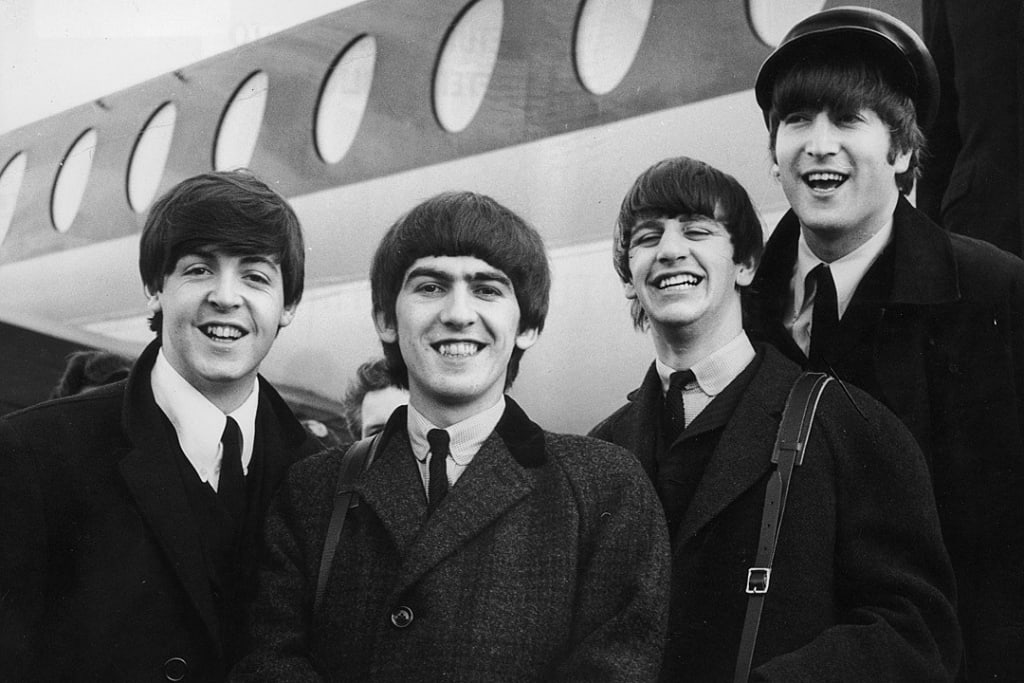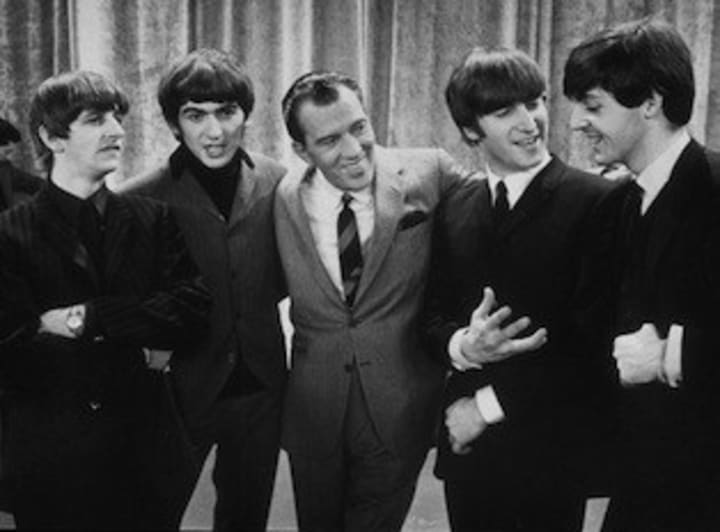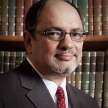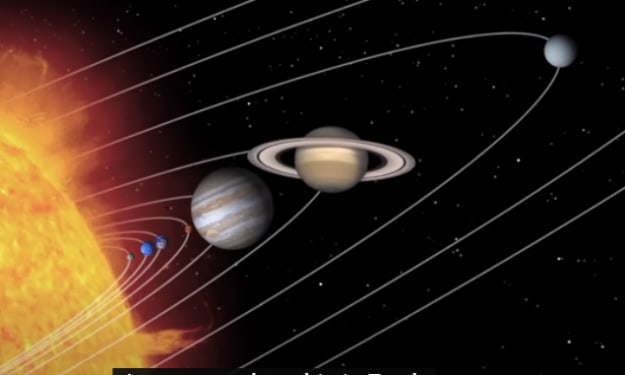
HISTORY OF THE BEATLES
On February 7, 1964, The Beatles landed at JFK Airport in New York. The airport had recently been renamed by a mourning country in honor of President Kennedy, who had been assassinated just 77 days earlier. The airport was now full of 4,000 greeters.
Not realizing why there was such a crowd, Paul McCartney wondered aloud, “Who is this for?” as the screaming fans rushed the gates to meet The Beatles. Two days later, on Sunday night, they would appear for their first of three consecutive Sunday night appearances on The Ed Sullivan Show.
First American Record Album
Meet The Beatles was the first record album I ever bought. A monochrome cover and a dozen monophonic songs opened with the clap-track augmented I Want To Hold Your Hand, then followed by I Saw Her Standing There, both were already massive hits in the US. To get a glimpse of the kind of cultural impact it had in America,– and the value of a clap-track — watch the Tom Hanks movie “That Thing You Do.”
Ed Sullivan Show

On Sunday nights in the ’60a, everyone watched The Ed Sullivan Show. My family watched it. Seventy-three million other Americans watched this particular show on February 9, 1964. I was glued to the TV set for what would become a cultural watershed moment in American history and one of the world’s top-viewed television events of all time. 60% of American TVs were tuned in to it; over 45% of Americans saw it.
Ed Sullivan introduced them with,
“Tonight, the whole country is waiting to hear England’s Beatles.”
The Fab Four performed five songs on the live broadcast. In glorious black and white, the personality of the British band came shining through as their names were superimposed over them as the camera panned to each one. Paul McCartney winked and smiled at the camera.
George Harrison was standing in the center, doing tight guitar licks. For John Lennon whose microphone barely worked, the caption below his name said:
“SORRY GIRLS, HE’S MARRIED.”
Davy Jones, who would later become a teen idol in The Monkees, sang on the show that night as the Artful Dodger with the cast of the Broadway musical “Oliver,” but who remembers. He did, and said to himself, “This is it, I want a piece of that.” There were 50,000 requests for the 700 seats for the Sullivan show.
Elvis Presley had previously been paid $50,000 for three appearances. The Beatles manager Brian Epstein negotiated top billing for The Beatles and three shows for $10,000. It was about exposure at this time, not money. Years later, Paul McCartney would go down in history as the most financially successful musician in history.
Trivia: a later British rocker would emerge named David Jones, but as the name was already “taken” he called himself David Bowie.
The Beatles at Carnegie Hall
Three nights later, they would do two shows at Carnegie Hall. Ticket prices were $4.00, $4.50, and $5.00. On February 11, they played in Washington DC’s Washington Coliseum to an audience of 8,000.
Beatlemania

Now Beatlemania had already been going on in the US. In 1963 radio stations were playing the UK single I Want to Hold Your Hand and the B-side I Saw Her Standing There. These were released on vinyl in the US the day after Christmas and sold 250,000 copies within three days, 1 million copies within ten days. Time Magazine wrote,
“They look like shaggy Peter Pans.”
British Invasion
The British Invasion had begun. While The Beatles were among the first wave — and perhaps more “parent acceptable” than others — they were followed by The Kinks, Dusty Springfield, Peter and Gordon, The Animals, Petula Clark, Herman’s Hermits, The Rolling Stones, The Dave Clark Five, Donovan, Lulu, and Gerry and the Pacemakers.
Their Merseybeat style of music, focusing around Liverpool in 1962, was a large impetus to this first wave. The second wave included The Who and The Hollies. This was all helped by British movies that had become popular in the US with actors like Julie Andrews (Mary Poppins), Audrey Hepburn (My Fair Lady), Michael Caine (Alfie), Peter O’Toole (Laurence of Arabia), and Sean Connery (James Bond.)
As Seth Godin said in his TED talk entitled “The Tribes We Lead”:
“The Beatles did not invent teenagers; they merely decided to lead them.”
Generational Impact of The Beatles
There was a rebellious tone to this style of rock and roll music, and the impact of The Beatles cannot be underestimated. My father at that time clearly illustrated the “generation gap” highlighted by The Beatles. He didn’t “get” The Beatles, not recognizing their powerful harmonization until another adult pointed it out to him.
Everyone recognized that they influenced clothing and hairstyle, but they did more than that. Their mid-career music contained both psychedelic (Lucy in the Sky with Diamonds) and drug themes (A Day In The Life.) Eastern religion (Across The Universe) and sitar music (Within You, Without You) became part of their later music.
Postmodernism

A number of historians, including this one, contend that The Beatles introduced Postmodernism into American culture. They clearly did so in music, which often influences culture, and I believe their music influenced it in the American worldview as well. Postmodernism had appeared in Europe earlier in the 1900s but not in America until the ’60s.
The worldview of Modernism that came with the Enlightenment in the late 17th century and Industrial Revolution in the 18th century with an emphasis on science, reason, and rationalism gave way to questions about authority and absolutes. It fit the zeitgeist of 1964 with its contradictions, irony, and pop culture. John Lennon’s statement, “We’re more popular than Jesus” was often misunderstood even when he tried to explain it, but that didn’t make it sit any better with Grandma. It is no understatement to say that they changed the American mind.

A generation ago, popular musicians served as the voice of their generation. During the ’60s, for example, millions of people hung on every word The Beatles said. They provided the musical score to the Summer of Love in 1967. They were the musical poets.
That is not true today of other artists. Are The Beatles still relevant? Paul McCartney still plays to sold-out arenas.
Several years ago while on a speaking trip to Manchester, I took a day to do a pilgrimage to nearby Liverpool, and got on a bus called The Magical Mystery Tour to visit the childhood homes, significant sites, and musical venues of the Beatles. I describe some of that in my Paul McCartney concert review here.
He plays the soundtrack of my life.
On 09/09/09 (“Number Nine, Number Nine, Number Nine”), Harmonix introduced their music-themed video game “The Beatles: Rock Band” with digitally remastered music. Their Cirque du Soleil show LOVE which opened in 2006 in Las Vegas is still a hot ticket, and in my opinion, worth seeing. The Beatles recently received the Lifetime Achievement Award from the Recording Academy.
Who was your favorite Beatle?
Bill Petro, your friendly neighborhood historian
If you enjoyed this article, please consider leaving a comment, subscribing to the news feed to have future articles delivered to your feed reader, or your email.
About the Creator
Bill Petro
Writer, historian, consultant, trainer
https://billpetro.com/bio






Comments
There are no comments for this story
Be the first to respond and start the conversation.